 Best compact:
Best compact:
Fujifilm F10
You’d be hard pressed to describe this box-like beast as a looker, but it consistently impressed us with its speed of operation, pin-sharp pictures and awesome low light performance.
Featuring a class-leading sensor, the Fuji can keep on delivering usable images right up to 1600 ISO – perfect for candid/low light photography.
Look out for the F11 which adds aperture and shutter priority to the feature set.
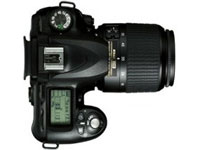 Best dSLR
Best dSLR
Nikon D50
A tough call this one with so many notable new cameras entering the increasingly competitive consumer end of the digital SLR market, but the Nikon D50 just pipped the Canon EOS 350D on account of its excellent image quality, low noise, excellent handing and, of course, incredible value for money.
This is a perfect first-time camera for amateur photographers keen to move up to a SLR system, and with hundreds of Nikon-fit lenses available, the D50 can handle just about every task you can throw at it.
Best prosumer camera
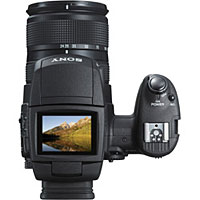 Sony Cyber-shot DSC-R1
Sony Cyber-shot DSC-R1
Just nudging ahead of the Fujifilm FinePix S9500, the Sony DSC-R1 impressed us with its innovation, build quality and fabulous images.
Dominated by a 24-120mm lens of truly outstanding quality, the DSC-R1 offers a unique viewfinder which can flip and twist through 270 degrees and offer medium format ‘waist level’ shooting.
Although it’s priced hard against more flexible dSLRS, you won’t find a more capable, all in one package than the Sony DSC-R1.
Biggest disappointment:
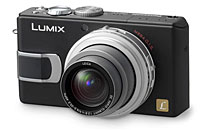 The Panasonic Lumix LX1
The Panasonic Lumix LX1
It promised so much, looked fantastic, entranced us with its advanced feature set, high end manual controls, widescreen aspect ratio, image stabilisation, razor sharp Leica lens and fantastic, crystal clear daytime images, but as soon as the sun went down and the ISO ratings went up – disaster!
A horrendously noisy sensor meant that noise crept in to even low ISO images, with pictures at 400 ISO bordering on unusable – not what you expect for £450.
Bring on the LX2 and Panasonic will have a killer camera on their hands!
 Internet auctioneer eBay have cancelled their plans to allow live pets to be sold on its Web site after receiving a barrage of complaints from users.
Internet auctioneer eBay have cancelled their plans to allow live pets to be sold on its Web site after receiving a barrage of complaints from users. As company spokesman Hani Durzy explained, users were concerned that the listings would encourage unsanitary ‘puppy mills’, where animals are sometimes bred in less-than ideal conditions, and that it might prove difficult working out legitimate animal shelters and the get-rich-quick scamsters.
As company spokesman Hani Durzy explained, users were concerned that the listings would encourage unsanitary ‘puppy mills’, where animals are sometimes bred in less-than ideal conditions, and that it might prove difficult working out legitimate animal shelters and the get-rich-quick scamsters. After a flurry of rumours and speculation, AOL and Google have announced that they have sealed the deal on an extended partnership deal, which sees Google shelling out $1bn for a 5% stake in AOL.
After a flurry of rumours and speculation, AOL and Google have announced that they have sealed the deal on an extended partnership deal, which sees Google shelling out $1bn for a 5% stake in AOL. Naturally, the synergistic shufflings don’t stop there, with plans being unveiled to make the two companies’ instant messaging tools work with each other and for Google to include AOL video in its video search database.
Naturally, the synergistic shufflings don’t stop there, with plans being unveiled to make the two companies’ instant messaging tools work with each other and for Google to include AOL video in its video search database.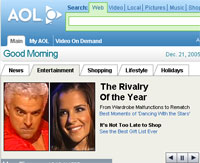 Sitting red faced in the corner and looking like a chump through all of this is Microsoft.
Sitting red faced in the corner and looking like a chump through all of this is Microsoft. The BBC has decided to extend the trial for the iMP Player until 28th February 2006, telling trialists that the extra time will enable it to “understand what you want from the service and how you are using it”. A new upgrade of the software is due to be rolled out to the participating trialists in January.
The BBC has decided to extend the trial for the iMP Player until 28th February 2006, telling trialists that the extra time will enable it to “understand what you want from the service and how you are using it”. A new upgrade of the software is due to be rolled out to the participating trialists in January. The BBC’s reaction to such sniping is consistent, if not a little bland
The BBC’s reaction to such sniping is consistent, if not a little bland We like “world firsts” so when integrated-circuit providers Micronas announced that they were the planet’s first company to incorporate a Dolby Virtual Speaker into a chipset designed specifically for televisions, we simply had to tell you all about it.
We like “world firsts” so when integrated-circuit providers Micronas announced that they were the planet’s first company to incorporate a Dolby Virtual Speaker into a chipset designed specifically for televisions, we simply had to tell you all about it.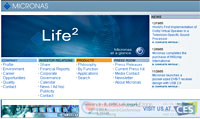 Dolby Virtual Speaker creates the illusion of five speakers by using room modelling techniques. This, apparently, sets it apart from other virtualizers.
Dolby Virtual Speaker creates the illusion of five speakers by using room modelling techniques. This, apparently, sets it apart from other virtualizers.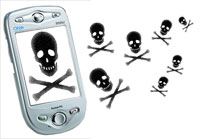 Anti-virus software vendors McAfee Avert Labs have released a dire warning about impending doom for smartphone users, claiming that mobile security threats are expected to triple next year.
Anti-virus software vendors McAfee Avert Labs have released a dire warning about impending doom for smartphone users, claiming that mobile security threats are expected to triple next year. Schmugar claimed that the consumers’ lack of interest in applying security software to their mobile devices (i.e not buying their software) is likely to compound the problem.
Schmugar claimed that the consumers’ lack of interest in applying security software to their mobile devices (i.e not buying their software) is likely to compound the problem.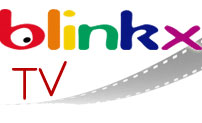 Blinkx have unveiled blinx.tv To Go, a new service that helps users track down online video content and then lets them upload it to their iPod or personal video player.
Blinkx have unveiled blinx.tv To Go, a new service that helps users track down online video content and then lets them upload it to their iPod or personal video player. Visitors searching the company’s database of video blogs and podcasts are able to either save the video to their player with a single click, or save the search to a channel which automatically feeds updated video content to their player, where it can be viewed as a single media stream.
Visitors searching the company’s database of video blogs and podcasts are able to either save the video to their player with a single click, or save the search to a channel which automatically feeds updated video content to their player, where it can be viewed as a single media stream. “Our vision of IPTV combines the interactive, customisable experience of the Internet, with the simple, seamless way we watch TV, and now we’ve made it portable,” Chandratillake added.
“Our vision of IPTV combines the interactive, customisable experience of the Internet, with the simple, seamless way we watch TV, and now we’ve made it portable,” Chandratillake added. Separately, a consolidating Carphone Warehouse has been on the acquisition trail and agreed the purchase of Tele2’s UK and Ireland operations, and separately, Onetel.
Separately, a consolidating Carphone Warehouse has been on the acquisition trail and agreed the purchase of Tele2’s UK and Ireland operations, and separately, Onetel. The purchase of Onetel from Centrica for £132 million includes £37.1 million, while will be delivered if Centrica deliver a targeted number of customers in the next three years via its British Gas operations. The Carphone Warehouse will also pay Centrica an additional £22.2 million if higher sign-up targets are met.
The purchase of Onetel from Centrica for £132 million includes £37.1 million, while will be delivered if Centrica deliver a targeted number of customers in the next three years via its British Gas operations. The Carphone Warehouse will also pay Centrica an additional £22.2 million if higher sign-up targets are met. Creative Zen Vision:M
Creative Zen Vision:M The player’s a versatile chap too, with the Vision:M outgunning the iPod by supporting a wider range of formats, like MP3, WMA and PlaysForSure audio formats and MPEG1/2/4, DivX and XviD, Motion JPEG and WMV for video.
The player’s a versatile chap too, with the Vision:M outgunning the iPod by supporting a wider range of formats, like MP3, WMA and PlaysForSure audio formats and MPEG1/2/4, DivX and XviD, Motion JPEG and WMV for video. Sony NW-A1000
Sony NW-A1000 The palm sized player (88 x 55 x 19 mm) comes with a built in 6GB hard drive and supports MP3 files as well as Sony’s ATRAC3 and ATRAC3+ audio formats. Battery life is claimed at 20 hours (although several reviews have found that figure to be wildly optimistic).
The palm sized player (88 x 55 x 19 mm) comes with a built in 6GB hard drive and supports MP3 files as well as Sony’s ATRAC3 and ATRAC3+ audio formats. Battery life is claimed at 20 hours (although several reviews have found that figure to be wildly optimistic). Apple iPod Nano
Apple iPod Nano Cambridge outfit, HD Positions, have launched their ‘Boomerang Box’ device, a new low cost, high accuracy positioning system which locates vehicles and other valuable assets.
Cambridge outfit, HD Positions, have launched their ‘Boomerang Box’ device, a new low cost, high accuracy positioning system which locates vehicles and other valuable assets. The service works by HD Positions supplying the interface to Matrix, facilitating related Machine to Machine (M2M) services, including network connectivity, billing and support.
The service works by HD Positions supplying the interface to Matrix, facilitating related Machine to Machine (M2M) services, including network connectivity, billing and support. We tried to find a picture of the actual Boomerang Box, hopeful that it would be an amusing looking thing that would spice up this rather dull report, but there was nothing to be found on their Website.
We tried to find a picture of the actual Boomerang Box, hopeful that it would be an amusing looking thing that would spice up this rather dull report, but there was nothing to be found on their Website.